Demand-Led Optimization of Urban Park Services
Abstract
:1. Introduction
2. Study Area and Date Sources
2.1. Study Area
2.2. Date Sources and Processing
3. Methods
3.1. Evaluation of Park Service Levels
3.2. Park Service Demand Evaluation
3.3. Coupling Coordination and Matching
3.4. Optimizing Park Service Levels: The GWO-KNN Model
- (1)
- K-Nearest Neighbor (KNN)
- (2)
- Grey Wolf Optimization (GWO)
4. Results
4.1. Analysis of Park Service Demand Levels
4.2. Analysis of Park Service Supply Levels
4.3. Analysis of Park Service Disparities in the Context of Supply and Demand Spatial Matching
4.4. Utilizing the GWO-KNN Model for Optimizing Park Service Levels
5. Discussion
5.1. Park Service Level Supply and Demand Matching Analysis
5.2. Maximizing Coordination for Park Service Level Optimization Strategy
- (1)
- Low service-coordination parks, mostly situated in suburban and outlying areas with small park sizes and abundant agricultural spaces, often struggle to meet basic recreational needs. In the future, attention should be directed toward the development of suburban parks with the addition of various facilities. These parks can utilize the surrounding green spaces to enhance park service levels. Take, for example, the area near Xixi Wetland Park and West Lake Scenic Area in the Yuhang District. This region is a key hub for innovative industrial parks in Hangzhou and is surrounded by farmland, cultivated land, and wetlands. While park service levels in this area are relatively low, the natural environment is favorable. In response, the approach should involve tapping into existing natural resources and historical culture. Without changing the existing land use, additional recreational features can be integrated to meet leisure and viewing activity requirements.
- (2)
- High service-coordination parks are positively influenced by ecological and picturesque national-level scenic areas such as West Lake Scenic Area, Xixi Wetland Park, and Wuchaoshan National Forest Park. Their levels of leisure, culture, facilities, and ecology are comparatively high. In the future, enhancing park construction quality and incorporating facilities friendly to vulnerable groups, such as the elderly and children, can create multi-functional parks to cater to the needs of diverse communities.
- (3)
- Low service-imbalance parks exhibit low levels of recreation, culture, facilities, and ecology, making it challenging to meet the needs of residents. Certain areas with insufficient facility levels in suburban and urban areas are especially concerning. Future park development should focus on expanding park sizes and increasing the quantity of park facilities and recreational infrastructure as an effective strategy to enhance park quality. Some areas have high ecological levels but low levels in culture, recreation, and facilities. They are located near scenic areas with well-developed ecological environments. Strengthening the complementary advantages between “new” and “old” cities and moderately expanding park sizes serve as the foundation for improving service levels. Increasing sports and cultural facilities, upgrading facility development, and boosting outdoor activities for residents and community park construction are key factors in optimizing service levels. Additionally, the region possesses the characteristic of dense water networks, which is commonly found in the Jiangnan region. Enhancing riverfront green space construction, integrating culture with facilities, and accommodating broad participation can serve as a reference for cities with similar intertwined water networks.
- (4)
- High service-imbalance parks exhibit high levels of recreation, culture, facilities, and ecology with an overall service level exceeding residents’ demands, resulting in resource wastage. To coordinate park service supply, spatial structures using limited land resources should be optimized and a city park network system should be constructed. Connections between high-quality parks and low-quality parks must be strengthened to reduce residents’ travel costs, enabling residents to enjoy green spaces. This approach will lead to fairer park service distribution.
6. Conclusions
- (1)
- Considerable variation exists in the park service demands of residents in different residential environments. Suburban and exurban areas with lower housing prices, high population density, limited green space per capita, and low floor area ratios experience high demand for parks. Areas with higher housing prices, larger population density, more green space per capita, and closer proximity to the city center favor community parks and pocket parks. The central urban area mainly consists of high-end villa communities and older neighborhoods. High-end villa communities generally have sufficient green spaces, while older neighborhoods have high demand for small recreational parks.
- (2)
- The overall trend in park service supply appears to radiate outward from the West Lake Scenic Area. However, there are significant differences between residential areas, and the general trend indicates that areas with higher living standards have higher park service supply levels. Despite these trends, discrepancies and coordination challenges persist, differing from existing research. Spatial characteristics led to the classification of spatial matching into four types: low-service coordination, high-service coordination, low-service discoordination, and high-service discoordination.
- (3)
- This study introduces an innovative approach to urban park service optimization by setting high-service coordination areas as sample regions and employing the GWO-KNN Model. For each of the four spatial types, specific strategies are proposed: (a) prioritizing the development of countryside parks, increasing the number of various facilities, utilizing the surrounding green resources, and enhancing park service levels; (b) adding facilities to cater to disadvantaged groups, creating multi-functional parks, and meeting the needs of diverse populations; (c) strengthening the complementary advantages of “new” and “old” areas, moderately increasing park sizes, combining culture and facilities, and comprehensively enhancing facility construction. (d) optimizing spatial structures, improving park quality, constructing an urban park network, enhancing connections between parks, and reducing residents’ travel costs.
Author Contributions
Funding
Data Availability Statement
Acknowledgments
Conflicts of Interest
Correction Statement
References
- Wang, M.M.; Wang, Y.C. Measurement and Optimization of Supply and Demand of Park Green Space at Urban Block Scale: A Case Study of Yangpu District, Shanghai. Landsc. Archit. 2021, 28, 22–27. [Google Scholar] [CrossRef]
- Liu, Y.; Zhang, X.Y.; Xu, M.J.; Guo, M.X.; Peng, A.Q.; Yu, C.T.; Yin, W.D. Spatial Differentiation Characteristics of Park from Perspective of Supply demand Synergy: Take Chaoyang District of Beijing as an Example. Urban Dev. Stud. 2022, 29, 12–19. [Google Scholar]
- Zhang, S.; Zhou, W. Recreational visits to urban parks and factors affecting park visits: Evidence from geotagged social media data. Landsc. Urban Plan. 2018, 180, 27–35. [Google Scholar] [CrossRef]
- Wang, Z.; Miao, Y.; Xu, M.; Zhu, Z.; Qureshi, S.; Chang, Q. Revealing the differences of urban parks’ services to human wellbeing based upon social media data. Urban For. Urban Green. 2021, 63, 127233. [Google Scholar] [CrossRef]
- Zhang, J.; Cheng, Y.; Wei, W.; Zhao, B. Evaluating Spatial Disparity of Access to Public Parks in Gated and Open Communities with an Improved G2SFCA Model. Sustainability. 2019, 11, 5910. [Google Scholar] [CrossRef]
- Verheij, R.; Maas, J.; Groenewegen, P. Urban—Rural Health Differences and the Availability of Green Space. Eur. Urban Reg. Stud. 2008, 15, 307–316. [Google Scholar] [CrossRef]
- Bryant, M.M. Urban landscape conservation and the role of ecological greenways at local and metropolitan scales. Landsc. Urban Plan. 2006, 76, 23–44. [Google Scholar] [CrossRef]
- Maas, J.; van Dillen, S.M.E.; Verheij, R.A.; Groenewegen, P.P. Social contacts as a possible mechanism behind the relation between green space and health. Health Place 2009, 15, 586–595. [Google Scholar] [CrossRef]
- Ozdil, T.R.; Modi, S.K.; Stewart, D.M. A ‘Texas three-step’ landscape performance research: Learning from Buffalo Bayou Promenade, Klyde Warren Park, and Ut Dallas Campus Plan. Landsc. Res. Rec. 2014, 2, 117–131. [Google Scholar]
- Chen, J.; You, W.B.; He, D.J.; Hu, X.S. Supply and demand relationship and its spatial heterogeneity of urban parks in downtown area of Fuzhou. J. Zhejiang AF Univ. 2023, 40, 1300–1310. [Google Scholar]
- Talen, E. The social equity of urban service distribution: An exploration of park access in pueblo, colorado, and macon, georgia. Urban Geogr. 1997, 18, 521–541. [Google Scholar] [CrossRef]
- He, P.; Chen, W.Z.; Cheng, Q.; Zhao, L. Research Progress of Chinese and International Spatial Justice in Urban Green Space. Chin. Landsc. Archit. 2019, 35, 28–33. [Google Scholar] [CrossRef]
- Yin, H.W.; Kong, F.H.; Zong, Y.G. Accessibility and equity assessment on urban green space. Acta Ecol. Sin. 2008, 28, 3375–3383. [Google Scholar]
- Zhang, J.G.; Song, A.Q.; Xia, T.Y.; Zhao, B. Evaluating the urban park green space exposure from the perspective of thecommunity life circle. J. Nanjing For. Univ. 2023, 47, 191–198. [Google Scholar] [CrossRef]
- Fan, P.; Xu, L.; Yue, W.; Chen, J. Accessibility of public urban green space in an urban periphery: The case of Shanghai. Landsc. Urban Plan. 2017, 165, 177–192. [Google Scholar] [CrossRef]
- Wu, J.; Feng, Z.; Peng, Y.; Liu, Q.; He, Q. Neglected green street landscapes: A re-evaluation method of green justice. Urban For. Urban Green. 2019, 41, 344–353. [Google Scholar] [CrossRef]
- Mao, Z.; Wang, W.; Ren, Z.; Zhang, D.; He, X. Recreational Attractiveness of Urban Parks and Implications for Their Management: A Case Study in Changchun, China. Chin. Geogr. Sci. 2022, 32, 456–466. [Google Scholar] [CrossRef]
- Wang, S.B.; Jiao, X.; Li, D.D.; Li, T.W. Review and Prospect of Research on Ecosystem Services: The Evolution from Functional Cognition and Value Accounting to Consumption Value Realization. For. Econ. 2021, 43, 49–67. [Google Scholar] [CrossRef]
- Kaczynski, A.T.; Stanis, S.A.W.; Besenyi, G.M. Development and Testing of a Community Stakeholder Park Audit Tool. Am. J. Prev. Med. 2012, 42, 242–249. [Google Scholar] [CrossRef]
- Wu, P.P.; Zhu, X.C.; Wang, W. Study on matching efficiency of supply and demand of public service function facilities in Shanghai: Analysis based on the heterogeneity characteristics of residents. Urban Probl. 2023, 04, 87–95. [Google Scholar]
- Jin, H.X.; He, G.; Huang, Q.S. Research on the Accessibility of Urban Green Space Through EnvironmentaJustice View: A Case Study of Hangzhou, China. J. Northwest For. Univ. 2022, 37, 261–267. [Google Scholar]
- Xu, H.F.; Xu, L.H.; Wu, Y.Q.; Shi, Y.J.; Lu, Z.W. Analysis on Accessibility and Fairness of Urban Public Green Space in Hangzhou. J. Southwest For. Univ. 2019, 39, 152–159. [Google Scholar]
- Peña, L.; Casado-Arzuaga, I.; Onaindia, M. Mapping recreation supply and demand using an ecological and a social evaluation approach. Ecosyst. Serv. 2015, 13, 108–118. [Google Scholar] [CrossRef]
- Crooks, A.; Pfoser, D.; Jenkins, A.; Croitoru, A.; Stefanidis, A.; Smith, D.; Karagiorgou, S.; Efentakis, A.; Lamprianidis, G. Crowdsourcing urban form and function. Int. J. Geogr. Inf. Sci. 2015, 29, 720–741. [Google Scholar] [CrossRef]
- Aamodt, G.; Nordh, H.; Nordbø, E.C. Relationships between socio-demographic/socio-economic characteristics and neighborhood green space in four Nordic municipalities—Results from NORDGREEN. Urban For. Urban Green. 2023, 82, 127894. [Google Scholar] [CrossRef]
- Liu, B.; Tian, Y.; Guo, M.; Tran, D.; Alwah, A.A.Q.; Xu, D. Evaluating the disparity between supply and demand of park green space using a multi-dimensional spatial equity evaluation framework. Cities 2022, 121, 103484. [Google Scholar] [CrossRef]
- Yu, S.; Zhu, X.; He, Q. An Assessment of Urban Park Access Using House-Level Data in Urban China: Through the Lens of Social Equity. Int. J. Environ. Res. Public Health 2020, 17, 2349. [Google Scholar] [CrossRef]
- Chen, L.; Yao, X.; Liu, Y.; Zhu, Y.; Chen, W.; Zhao, X.; Chi, T. Measuring Impacts of Urban Environmental Elements on Housing Prices Based on Multisource Data—A Case Study of Shanghai, China. ISPRS Int. J. Geo-Inf. 2020, 9, 106. [Google Scholar] [CrossRef]
- Dou, J.M.; Wang, G.L. Structure on Urban Land Price Research on the lnfluence Mechanism of Urban Polycentric Economic Spatia. Inq. Into Econ. Issues 2022, 119–134. [Google Scholar]
- Lu, Z.D. Relationship between City Expansion, City Transformation and Carbon Dioxide Emissions of China. Areal Res. Dev. 2014, 33, 121–126, 131. [Google Scholar]
- Yin, W.Y.; Shao, D.W.; Wu, D.M. Effect of Residential Space Differentiation on Park Green Space Pattern: A Case Study of Suzhou City. Areal Res. Dev. 2023, 42, 81–87. [Google Scholar]
- Meng, L.; Li, Q. Relationship between supply and demand of green open space in Haidian District of Beijing based on accessibility. J. Beijing For. Univ. 2023, 45, 108–119. [Google Scholar]
- Zhang, J.; Tan, P.Y. Assessment of spatial equity of urban park distribution from the perspective of supply-demand interactions. Urban For. Urban Green. 2023, 80, 127827. [Google Scholar] [CrossRef]
- Chen, Y.S.; Li, D.; Wang, Y.C.; Li, Y.Y. Evaluation and layout optimization of park green space in central urban area of Hefei City based on POl data. J. China Agric. Univ. 2023, 28, 87–97. [Google Scholar] [CrossRef]
- Xu, Y.-X.; Chen, Y.-X.; Su, J.; Yin, H.-W.; Cheng, L.; Zeng, H. Using the environmental justice approach to evaluate equitable allocation of urban parks: A case study of main urban area of Nanjing, China. Chin. J. Appl. Ecol. 2022, 33, 1589–1598. [Google Scholar] [CrossRef]
- Chen, Y.; Men, H.; Ke, X. Optimizing urban green space patterns to improve spatial equity using location-allocation model: A case study in Wuhan. Urban For. Urban Green. 2023, 84, 127922. [Google Scholar] [CrossRef]
- Xing, L.J. Optimization the Layout of Urban Park Green Space under the Guidance of the Concept of Equality. Ph.D. Thesis, Wuhan University, Wuhan, China, 2019. [Google Scholar] [CrossRef]
- Ma, J.; Cheng, Y.N. Research on Optimization of Urban Park Design Based on Swarm Intelligent Simulation and Spatial Syntax Analysis. Chin. Landsc. Archit. 2021, 37, 69–74. [Google Scholar] [CrossRef]
- Lu, Y.C.; Fang, S.M. Study on the Spatial Distribution Optimization of Park Green Spaces in the Main City of Wuhan from the Perspective of Both Equilibrium and Efficiency. Resour. Environ. Yangtze Basin 2019, 28, 68–79. [Google Scholar]
- Yu, M.; Xu, D.; Ding, K.; Li, Y.Y. Evaluation and Optimization of Recreation Service in the Great Wall NationaCultural Park (Beijing Section). Landsc. Archit. 2023, 30, 108–116. [Google Scholar] [CrossRef]
- Li, C.T.; Zhang, Y.C.; Zhang, G.Y.; Li, R.; Zhang, L. Quantitative Study on the Quality of Green Space in Urban Parks. J. Beijing Univ. Civ. Eng. Archit. 2021, 37, 20–31. [Google Scholar] [CrossRef]
- Tao, C.; Li, J.X.; Lai, D.Y. Public Activity Space Quality Evaluation and Optimization Strategy. Planners 2021, 37, 75–83. [Google Scholar]
- Xue, M.; Jiang, S.J.; Wang, R.C. Systematic review of test data generation based on intelligent optimization algorithm. Comput. Eng. Appl. 2018, 54, 16–23. [Google Scholar] [CrossRef]
- Lu, H.X. Classification Model of IoT Intrusion Detection Based on GWO-CatBoost. Master’s Thesis, Lanzhou University, Lanzhou, China, 2020. [Google Scholar] [CrossRef]
- Zhang, X.F.; Wang, X.Y. Comprehensive Review of Grey Wolf Optimization Algorithm. Comput. Sci. 2019, 46, 30–38. [Google Scholar] [CrossRef]
- Yan, X.J.; Wang, Y.L.; He, G.P. A Survey on the Active Set Methods for Box Constrained Optimization. Math. Pract. Theory 2012, 42, 100–107. [Google Scholar]
- Yuan, Z.Q.; Zhao, C.Y. Two improved simulated annealing algorithms for solving constraint satisfaction problems with large domains. Appl. Res. Comput. 2017, 34, 3611–3616. [Google Scholar]
- Adithiyaa, T.; Chandramohan, D.; Sathish, T. Optimal prediction of process parameters by GWO-KNN in stirring-squeeze casting of AA2219 reinforced metal matrix composites. Mater. Today Proc. 2020, 21, 1000–1007. [Google Scholar] [CrossRef]
- Zhang, R.; Peng, S.; Sun, F.; Deng, L.; Che, Y. Assessing the social equity of urban parks: An improved index integrating multiple quality dimensions and service accessibility. Cities 2022, 129, 103839. [Google Scholar] [CrossRef]
- Lu, N.; Li, J.Y.; Yan, H.W.; Shi, T.; Li, Y. Analysis on accessibility of urban park green space: The case study of Shenyang Tiexi District. Chin. J. Appl. Ecol. 2014, 25, 2951–2958. [Google Scholar] [CrossRef]
- Wu, S.; Wang, D.; Yan, Z.; Wang, X.; Han, J. Coupling or contradiction? The spatiotemporal relationship between urbanization and urban park system development in China. Ecol. Indic. 2023, 154, 110703. [Google Scholar] [CrossRef]
- Li, Y.; Sang, J.J.; Ao, R.H.; Ma, Y.; Wei, X. Research on inversion method of hyperelastic constitutive parameters of skeletal muscles based on simulation and intelligent algorithm. Chin. J. Theor. Appl. Mech. 2021, 53, 1449–1456. [Google Scholar] [CrossRef]
- Kumar, V.; Chhabra, J.K.; Kumar, D. Grey Wolf Algorithm-Based Clustering Technique. J. Intell. Syst. 2017, 26, 153–168. [Google Scholar] [CrossRef]
- Ma, X.; Zhang, Z.; Dong, J.; Gao, F.; Li, R. Spatial Distribution and Supply & Demand Matching of Parks-A Case Study of Lanzhou City. J. Northwest For. Univ. 2021, 36, 289–296. [Google Scholar]
- Wu, J.; He, Q.; Chen, Y.; Lin, J.; Wang, S. Dismantling the fence for social justice? Evidence based on the inequity of urban green space accessibility in the central urban area of Beijing. Environ. Plan. B Urban Anal. City Sci. 2020, 47, 626–644. [Google Scholar] [CrossRef]
- Woo, Y.; Webster, C. Co-evolution of gated communities and local public goods. Urban Stud. 2014, 51, 2539–2554. [Google Scholar] [CrossRef]
- Astell-Burt, T.; Feng, X.; Mavoa, S.; Badland, H.M.; Giles-Corti, B. Do low-income neighbourhoods have the least green space? A cross-sectional study of Australia’s most populous cities. BMC Public Health 2014, 14, 292. [Google Scholar] [CrossRef] [PubMed]
- Chen, Y.; Yue, W.; La Rosa, D. Which communities have better accessibility to green space? An investigation into environmental inequality using big data. Landsc. Urban Plan. 2020, 204, 103919. [Google Scholar] [CrossRef]
- Barbosa, O.; Tratalos, J.A.; Armsworth, P.R.; Davies, R.G.; Fuller, R.A.; Johnson, P.; Gaston, K.J. Who benefits from access to green space? A case study from Sheffield, UK. Landsc. Urban Plan. 2007, 83, 187–195. [Google Scholar] [CrossRef]



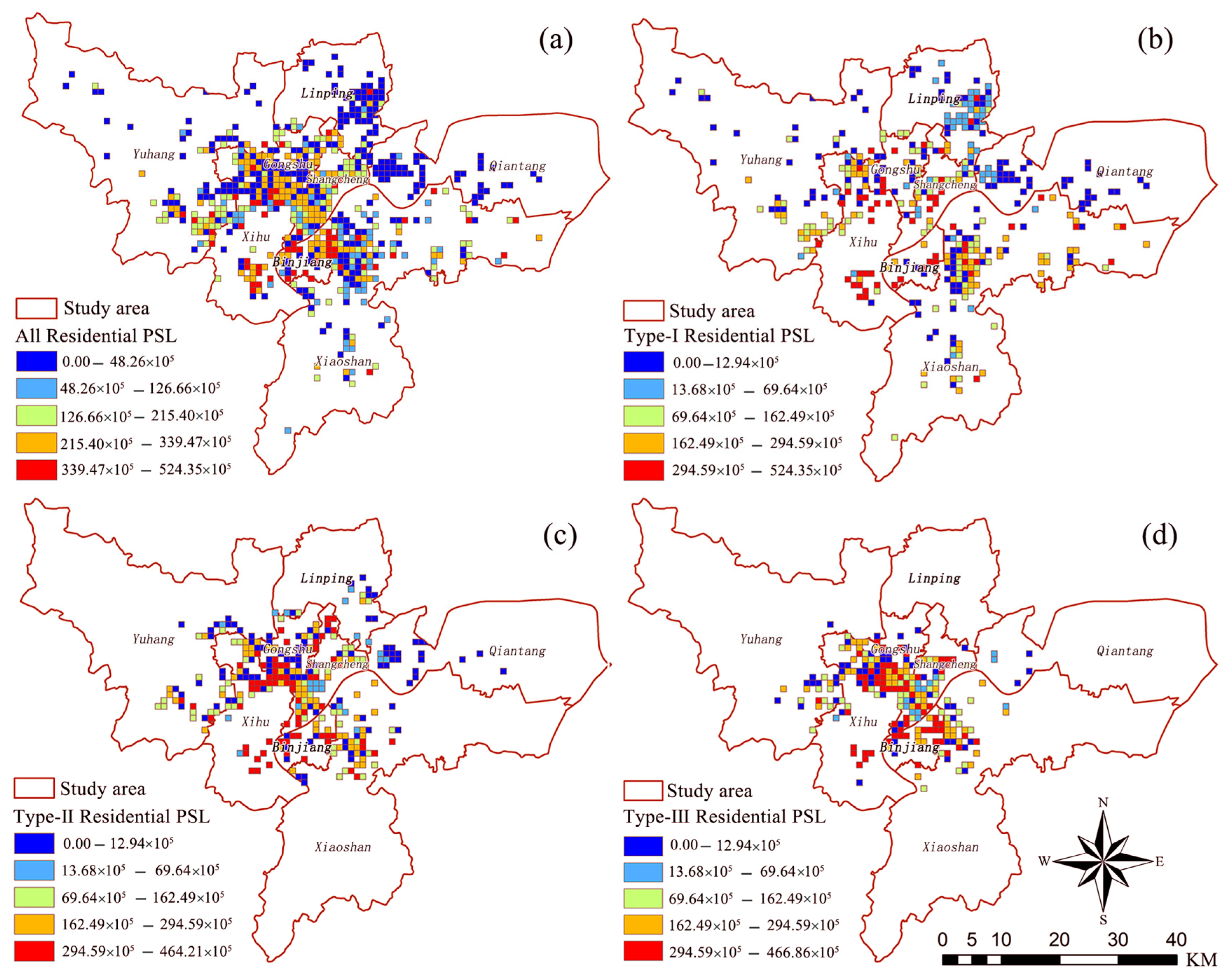


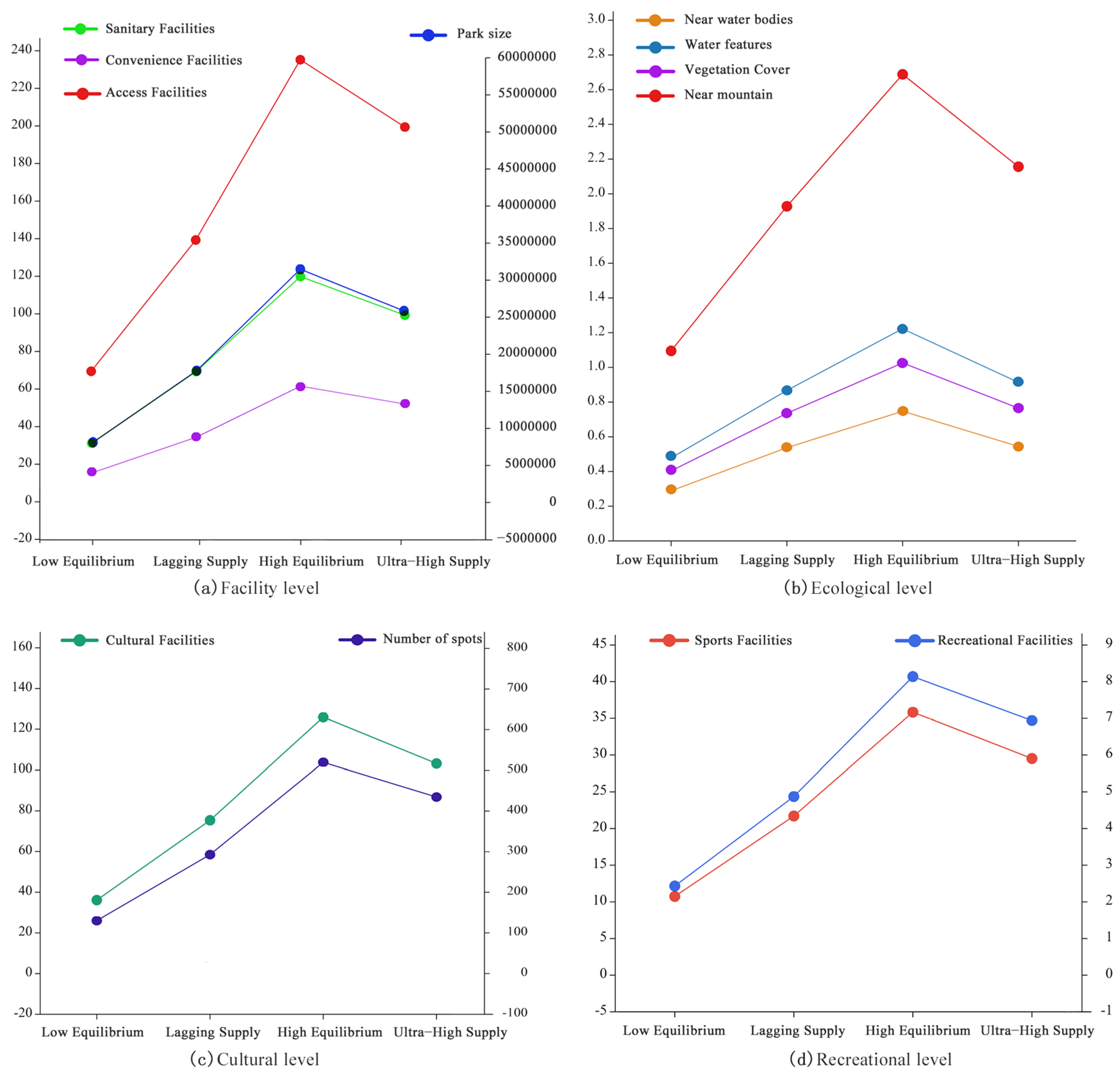


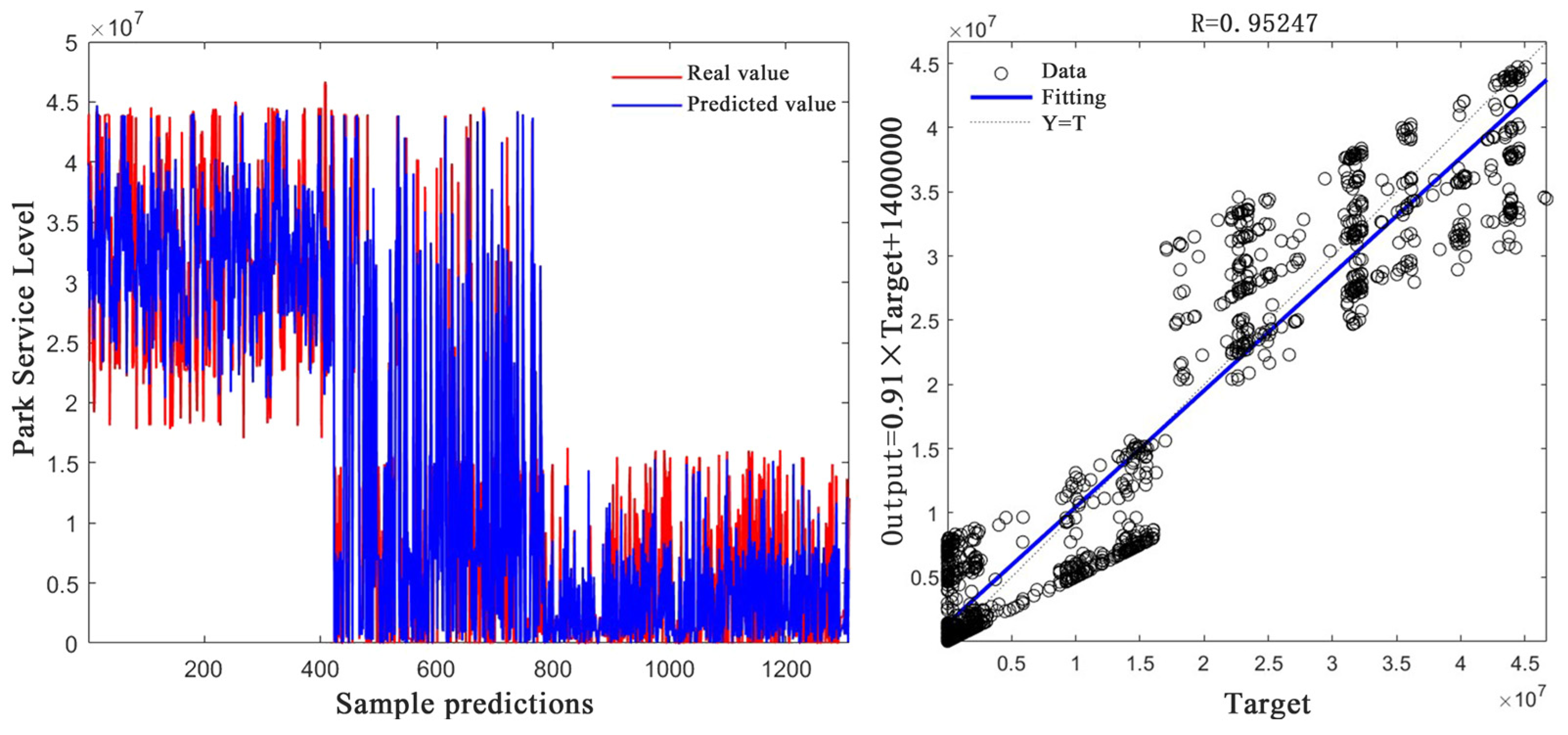
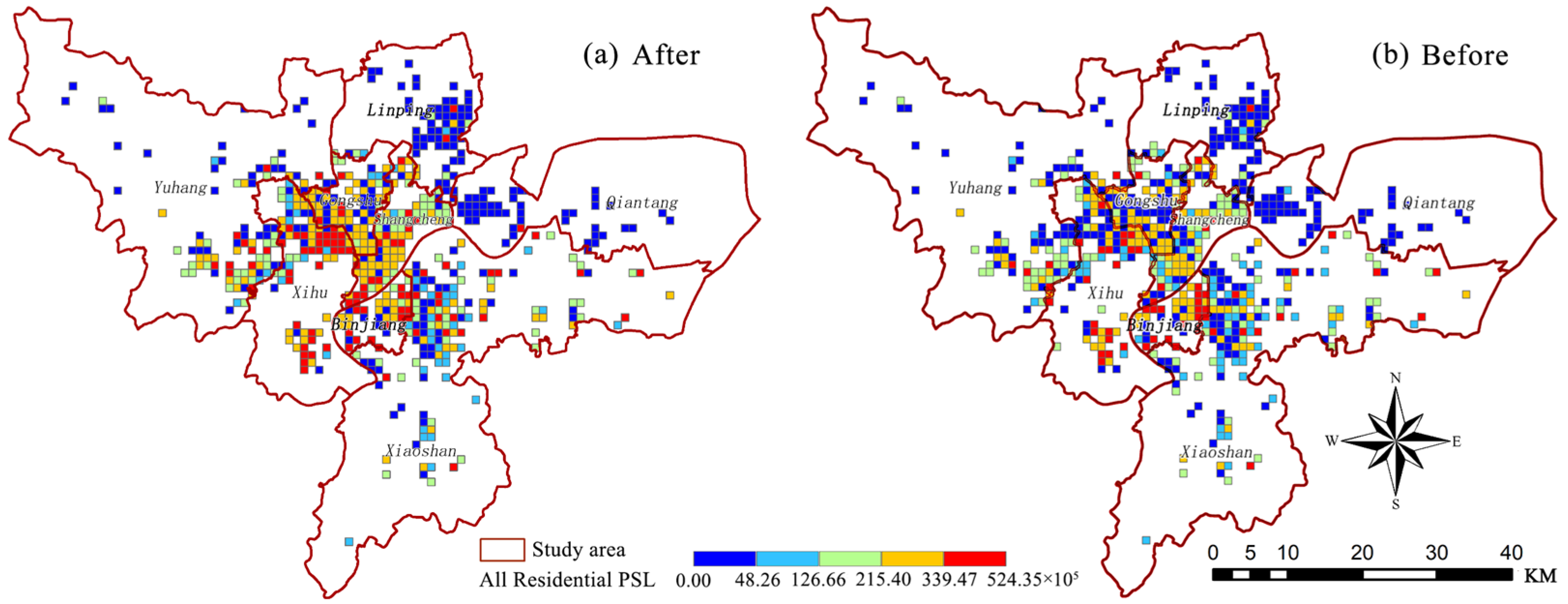
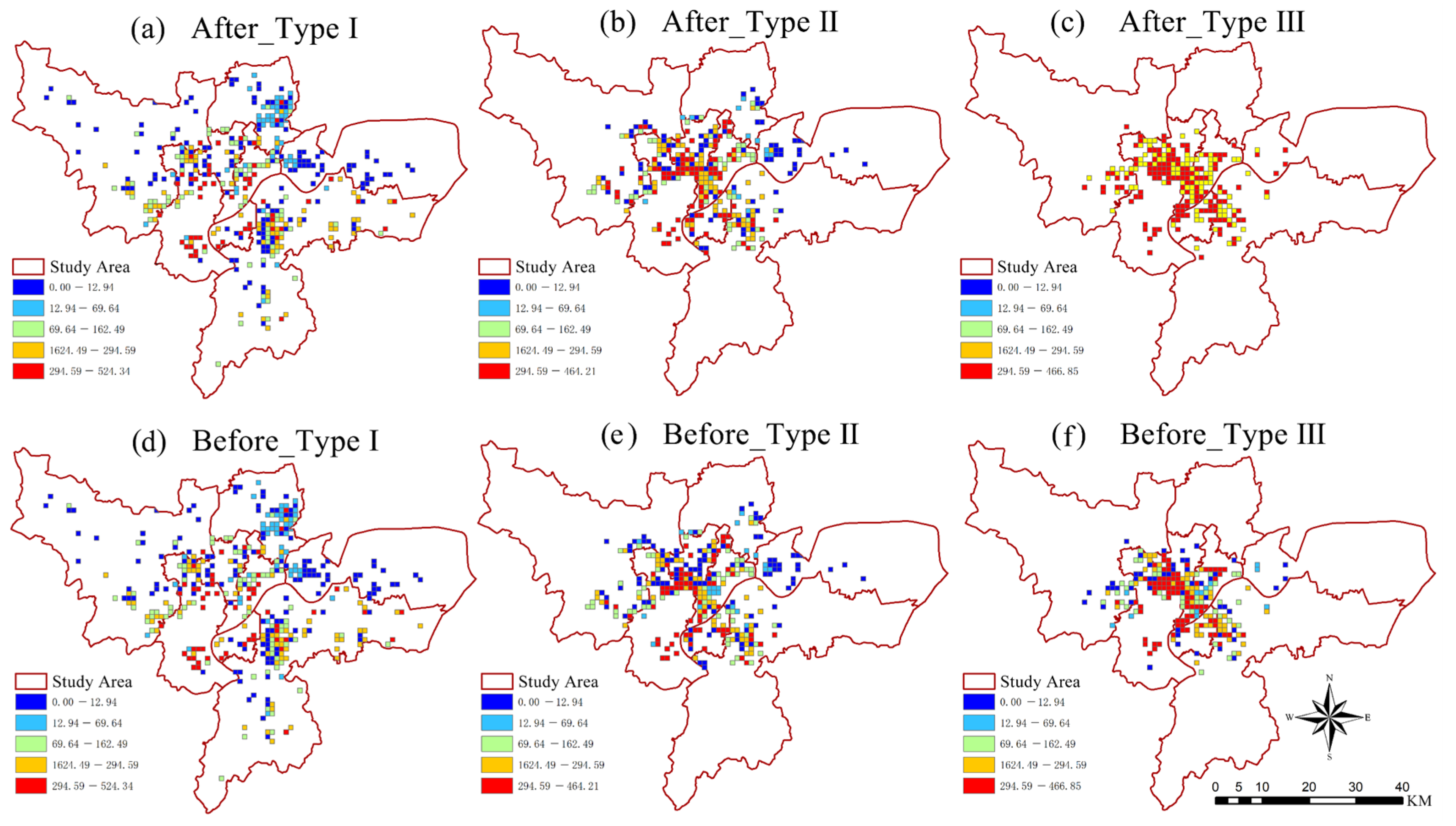


| Level 1 Indicators | Weight | Level 2 Indicators | Indicator Details | Weight |
|---|---|---|---|---|
| A Recreational level | 0.2127 | A1 Sports facilities | Courts, fitness facilities, etc. | 0.0806 |
| A2 Recreational facilities | Amusement rides, campgrounds, theaters, etc. | 0.1321 | ||
| B Ecological level | 0.0815 | B1 Water features | Percentage of water | 0.0278 |
| B2 Vegetation cover | / | 0.0063 | ||
| B3 Near mountain | Yes is 1, No is 0 | 0.0448 | ||
| B4 Near water bodies | Yes is 1, No is 0 | 0.0026 | ||
| C Cultural level | 0.2315 | C1 Cultural facilities | Exhibition halls, museums, art galleries, etc. | 0.0849 |
| C2 Number of spots | Number of spots (POI) | 0.1466 | ||
| D Facility level | 0.4743 | D1 Park size | Area of park (AOI) | 0.1160 |
| D2 Access facilities | Number of parkings | 0.1124 | ||
| D3 Sanitary facilities | Number of restrooms | 0.1160 | ||
| D4 Convenience facilities | Number of convenience stores | 0.1299 |
| Residential Quality Indicators | Nature of Indicator | Weight |
|---|---|---|
| Population size | Negative | 0.09 |
| House price | Positive | 0.27 |
| Floor area ratio of the residential area | Negative | 0.25 |
| Green space per capita in the residential area | Positive | 0.39 |
Disclaimer/Publisher’s Note: The statements, opinions and data contained in all publications are solely those of the individual author(s) and contributor(s) and not of MDPI and/or the editor(s). MDPI and/or the editor(s) disclaim responsibility for any injury to people or property resulting from any ideas, methods, instructions or products referred to in the content. |
© 2023 by the authors. Licensee MDPI, Basel, Switzerland. This article is an open access article distributed under the terms and conditions of the Creative Commons Attribution (CC BY) license (https://creativecommons.org/licenses/by/4.0/).
Share and Cite
Tong, A.; Qian, X.; Xu, L.; Wu, Y.; Ma, Q.; Shi, Y.; Feng, M.; Lu, Z. Demand-Led Optimization of Urban Park Services. Forests 2023, 14, 2371. https://doi.org/10.3390/f14122371
Tong A, Qian X, Xu L, Wu Y, Ma Q, Shi Y, Feng M, Lu Z. Demand-Led Optimization of Urban Park Services. Forests. 2023; 14(12):2371. https://doi.org/10.3390/f14122371
Chicago/Turabian StyleTong, Anqi, Xiaohu Qian, Lihua Xu, Yaqi Wu, Qiwei Ma, Yijun Shi, Mao Feng, and Zhangwei Lu. 2023. "Demand-Led Optimization of Urban Park Services" Forests 14, no. 12: 2371. https://doi.org/10.3390/f14122371
APA StyleTong, A., Qian, X., Xu, L., Wu, Y., Ma, Q., Shi, Y., Feng, M., & Lu, Z. (2023). Demand-Led Optimization of Urban Park Services. Forests, 14(12), 2371. https://doi.org/10.3390/f14122371







